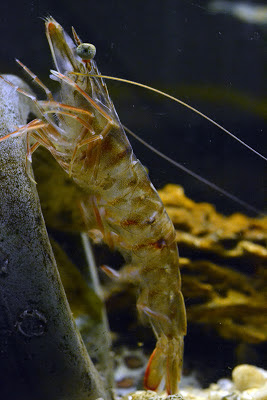We had created a new shrimp exhibit just prior to the flash flood that destroyed the lower level of the museum. This exhibit was one of the nine exhibits that suffered extensive damage; in fact this exhibit had to be completely replaced. So after nearly two full months it is finally back up and running.
Shrimp are largely thought of in regards to how they are cooked. Most people are familiar with the types of shrimp on a menu:
fried shrimp, grilled shrimp, steamed and spiced shrimp, etc. but few people
are familiar with the actual animal. In fact, the common edible “shrimp” is a
catch-all term for several different species. On the East Coast, native edible
shrimp species are closely related members of the Penaeus Family: pink, brown, or white shrimp named for their shell
color. The habitats of these three species overlap and they can be difficult to
distinguish.
A live version of the ever-popular shrimp Penaeus sp.
Shrimp are from an order of crustaceans called decapods -
meaning literally “ten feet”- which also includes crabs, lobsters, and crayfish.
Most decapods are opportunistic benthic omnivores, meaning they use their
nimble legs and claws to crawl along the bottom and devour virtually anything
edible. But shrimp, crayfish, and lobsters also possess extremely powerful,
muscular tails which they can contract to propel themselves backwards swiftly
when threatened. It is these muscular tails that entice so many; aside from
humans, shrimp are the favorite prey of many animals including sea trout, drum,
flounder, actually just about anything.
A blue crayfish or "crawdad" in our quarantine room
The Bay populations of pink, white, or brown shrimp are not
abundant enough to sustain a commercial fishery as they are most common in
large numbers from North Carolina
southward, but there are several species of non-edible shrimps in the Bay. Grass
shrimp Palaemonetes sp. are too small for humans to eat (>
2”) but are by far the most abundant shrimp; present in massive numbers
throughout the shallow water of the Bay, far up into rivers, even into freshwater.
A grass shrimp Palaemonetes sp. eats a piece of gel
Other local shrimp species include: sand shrimp, rock shrimp, mud shrimp,
snapping shrimp, mantis shrimp, et al., none of which are of any direct
commercial importance and thus go largely unnoticed by humans.
A crangon shrimp or "sand shrimp" is one of the lesser known shrimp in the Bay
And just for fun, we will throw in some non-shrimp crustaceans to keep it interesting, such as: spider crabs, calico box crabs, urchins, and even a couple of live scallops. Below is a video of our calico box crab molting be patient - it's worth it!




Shrimpguy, the grass shrimp photo would be great for a handout I want to give to volunteers monitoring marsh recovery. Would like to tell you what we have in mind and ask permission - please contact me at beriniki (gmail) Thanks!
ReplyDelete